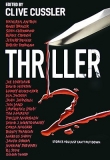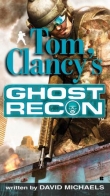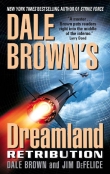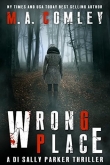
Текст книги "Ghost Fleet: A Novel of the Next World War"
Автор книги: P. Singer
Соавторы: August Cole
Жанр:
Триллеры
сообщить о нарушении
Текущая страница: 6 (всего у книги 37 страниц)
Pier 29, Port of Honolulu, Hawaii
What the hell? They weren’t supposed to be offloading for another day.
When he’d first seen the ramp come down, Jakob Sanders had pulled out his tablet to recheck the manifest. The Golden Wave, 720 feet, flagged out of Liberia. A RO/RO carrying cars from Shanghai. It had been pre-cleared on the manifest but it was twenty-four hours early. And now it was mucking up his day.
Even standing in the guard shack in the neighboring parking lot, he could feel the impact of the doublewide metal ramp slamming down onto the pier. Sanders had always thought the big roll-on, roll-off ship had the aesthetic appeal of a Costco plunked down on top of a boat. But that was the idea. It could carry 550 vehicles, and those vehicles could drive right off the ship and into his lot. Where they would then sit, waiting to be driven to various dealerships around the island.
Sanders tried to raise his boss on the radio but all he got was static. He shook his head and looked down to check the time and date on his Casio G-Lide watch. Yep, he had it right. They were offloading too soon. More important, the web-enabled watch’s last update showed that the offshore buoy readings looked promising for some head-high swells. Just five more hours in the lot and then he’d be free of his guard shack and back in the water at Kewalos. If the surf was as good as his watch promised, it would be one of those days when it just didn’t matter where you’d gone to school or that you wore a black polyester uniform on land.
A series of distant booms snapped his attention from his watch. He hit the deck and covered his head with his arms as the shack’s flimsy metal walls shook. After a few seconds, he got to his knees and peered through the open door at the fuel-tank farm next to pier 29. No fire. Blue skies didn’t indicate thunder. Then the pier began to vibrate again from another low rumble, like an earthquake. Damn, he didn’t want to be caught here by the water if it led to a tsunami.
More distant booms echoed off the hills, but the noise was washed out by hundreds of motors starting up inside the Golden Wave. What were they doing? Didn’t they feel the quake? There could be more aftershocks.
Sanders remembered the public-service announcements he’d watched as a kid said you should stand in a doorway during an earthquake, but he looked at the flimsy shack walls and then crawled outside. He felt more booms reverberate and saw some smoke rising behind the Golden Wave, but the bulk of the huge ship blocked whatever was happening across the harbor.
Then one of those new Geely SUVs rolled down the ramp. Maybe they were trying to get the cars off before another quake? But where were they going to park them? They’d be better off keeping them on the ship and riding it out.
Sanders watched as another and then another of the SUVs moved down the ramp and parked. He’d always thought the Geely looked like a ripped-off Range Rover Defilade. But they were so cheap that he could almost afford one. The paint sure sucked, though. The first dozen were a decent silver or blue. But the rest were a faded matte green.
Then he heard a piercing squeal, like something gouging the steel deck of the ship. Behind the last SUV, what looked like a telephone pole on its end gradually emerged and pointed down the ramp. Behind that pole was a massive green bulk that slowly nosed its way out to the top of the ramp and then tilted downward.
Shit, that was a tank! Then another tank moved down the ramp, followed by an eight-wheeled vehicle that looked like a tank’s little brother.
Sanders saw the red stars on the tanks. What were Chinese tanks doing coming off the ship? The manifest said nothing about that. And who the hell would be buying those? Maybe they were for training exercises out at Camp Schofield?
Jakob looked around and realized he was alone.
His next move was to bring out his phone and start shooting video. It would be worth a couple beers; maybe he could even sell it on the viz-net.
Then what looked like six beer kegs flew up into the air and raced toward downtown. “Drones?” Sanders said in a whisper.
Each squat Pigeon surveillance drone was indeed about the size of a fourteen-gallon beer keg, and each had a small rotor bay at its bottom. They all took off to seek out the highest points in Honolulu, where they would land. From these perches, the unarmed Pigeons would suck in electromagnetic and digital signals and then throw out an island-wide wave of electronic disturbance.
Just then Jakob heard another bang on the pier. It was the ramp coming down off the Hildy Manor, another RO/RO tied up beyond the Golden Wave. None of this shit was authorized. They didn’t have the paperwork, and the lot was already going to be jammed. There was no way he’d be able to fit the cars from not one but two ships into the waiting lot, let alone a bunch of tanks.
He held the phone at arm’s length, cursing his stupid job again, this time because he couldn’t afford some viz glasses.
“Jakob Sanders at pier twenty-nine in Honolulu,” he said, staring into the pinhole camera. “Got an unauthorized delivery here as you can see,” Sanders said. “Some trucks, Geelys, and check this out, tanks! Chinese tanks. Not sure what the drill is today, but we’re about to go find out. Bet you never saw anything like this in real life. Me either. Stay tuned.”
Sanders set his phone on the windowsill in his shack so that it was recording the scene and then marched with a bold step toward the Golden Wave. Dumb-ass sailors. They’d just have to stay on the pier until it all got sorted out.
By the time Sanders had made his way to the ramp that connected the pier to the parking lot, he could literally feel the power of the tanks’ engines in his chest. The tanks slowly moved forward, a few feet at a time, testing the ramp.
A flash of movement and an earsplitting clang made him whip his head around. Big metal panels were being tossed over the side of the Evening Resolve – a 480-foot cargo container ship registered in Dalian – and landing on the pier. Then a miniature air force began to assemble in formation above the Evening Resolve. To Sanders, the quadcopters looked like those spy drones the paparazzi used to buzz any Hollywood star dumb enough to still have an outdoor wedding. The Directorate’s electric V1000 drone actually shared a heritage with the commercial systems, but its agility and stealth had made it the platform of choice for covert Chinese “risk-elimination” strikes in Africa and the former Republic of Indonesia.
The tanks throttled their engines again and regained Sanders’s attention. He raised his right hand in the universal sign to stop.
“Halt! You are entering private property. I need you to stop that vehicle immediately.”
The lead tank slowed and then stopped at the bottom of the ramp, just ten feet away. Sanders looked down and raised his voice, more confident now that he had established who was in charge.
“Good. Now, I don’t know what’s going on but you need to turn that vehicle around and get back on the ship… immediately.”
The engine belched smoke, and the tank suddenly bounded forward.
Seen on the screen of his phone, it looked like a symbolic act of bravery. In actuality, all Jakob could think about was running, running as fast as he could, to get out of the sixty-ton beast’s path. But his feet just wouldn’t move.
Marine Corps Base, Kaneohe Bay, Hawaii
Captain Charles Carlisle was losing patience with his crew chief. In other words, it was just another day in paradise with a jet more finicky than his fiancée.
The 25 mm gun pod on his F-35B Lightning II fighter kept jamming after each helicopter-like vertical landing he performed. This was the fourth time this week, but no one could figure out why. The plane’s autonomic maintenance computers were supposed to point fingers at any gremlins, but adding more to the twenty-four million lines of software code already in there just proved Murphy’s Law beat Moore’s Law every time.
“I don’t know what to tell you, Worm,” said Miller, the civilian crew chief, using the call sign Carlisle had earned after losing his rations and living off worms during the survival-and-evasion phase of his pilot training. “I didn’t design these planes; I just fix ’em.”
Worm shook his head. He’d never gotten why the Marine Corps put the world’s best pilots in the cockpits of the world’s most expensive weapons system only to turn maintenance over to the lowest bidder.
Worm was about to offer another round of profane observations about what $1.5 trillion ought to buy – like, for instance, a working gun – but then he held his breath and listened. Weird. A series of bass-like thumps. Then he heard the buzzing of rotors. It came from the direction of Pearl and moved toward the air station located on the Mokapu Peninsula. The blood drained from the aviator’s face when he saw the flight of choppers and tiny quadcopter drones.
“Get the fuel hose off, now!” Worm shouted.
The crew chief was about to argue when he tracked the pilot’s gaze and saw the formation of incoming choppers. Miller looked old, but he was down on the ground before the first wave of rockets hit the hangar complex on the other side of the 7,800-foot runway.
“Miller, up! Get up!” shouted Worm.
Lying prone, Miller watched four of the quadcopters dive and attack a communications tower at the end of the runway. Just before the V1000s launched a volley of micro-rockets, they flared back into formation, which made them look like Xs on a fiery tic-tac-toe board.
“I’m on it!” said Miller. You could question his competence, but you couldn’t fault the man’s bravery, thought Worm.
As the two men worked to pull the fuel line from the F-35, Miller spoke between panting breaths.
“Chinese?” he said.
“Does it matter?” said Worm. “Get me up there, and I’ll send a few down here for you to pick through and find out.”
They could see the drone helicopters methodically working their way across the base’s hangar buildings, hitting one aircraft after the other. That they remained in an X formation the whole time made the attack seem all the more menacing. A few Marines shot rifles at them, only to be taken out by rocket fire from above. Fortunately, Worm’s F-35B, like its predecessor the Harrier jump jet, didn’t need to approach the killing field of the runway. The aircraft had a shaft-driven fan in the middle of its fuselage that could lift the plane into the air like a helicopter, after which the plane’s main jet engine would push it forward with over forty thousand pounds of thrust.
The tradeoff of packing a second engine in the middle of the plane was that the Marine version of the F-35 couldn’t carry as much payload, but Worm’s jet would be flying with a light load anyway. The good news was that the training exercise they had been prepping for was a live-fire drill. The bad news was it was for close air support, so he was loaded with only dummy air-to-air missiles and a gun pod he couldn’t trust.
Worm clambered into the cockpit and looked down at Miller, the top half of his head encased in a heads-up-display visor-and-helmet combination that looked like a bug’s carapace. He shouted and pointed at the jet’s fuselage: “The gun? The gun?”
Miller scrambled up the ladder to the cockpit and leaned in close enough to Worm that he could smell the sharp stink of sweat mixed with jet fuel. “Maybe a hundred rounds before it jams,” he shouted. Shit. At the machine cannon’s rate of fire, that was possibly three seconds’ worth of shooting.
Worm gave a quick look at the plane’s cockpit screens to make sure the aircraft was running the preflight checks. At least something was working as it should.
For a second, maybe two, Worm allowed himself to think of his fiancée. She’d be out surfing about now, working off some of the dark energy her dreams often left her with. They were supposed to meet at the Moana Surfrider hotel that night for a drink. She hadn’t told him which of the bars she’d be in, though; she never did. He would have to find her, and then they would sip mai tais and fantasize about what it would be like to get married there. He had promised her a fairy-tale ending to her story.
The image was dashed as the canopy closed down. Worm flashed a thumbs-up to the crew chief below and mouthed a word.
Payback.
USS Coronado, Joint Base Pearl Harbor – Hickam, Hawaii
An antitank rocket fired from a nearby freighter hit the USS Gabrielle Giffords, moored nearby. It was unnecessary; the Giffords was already taking on water from an explosion below the water line, as were most of the U.S. Navy warships in the harbor.
“Is ATHENA online yet?” shouted Captain Riley. The Automated Threat Enhanced Network Awareness program was like the ship’s nervous system, tying together sensors and network nodes with software that was as close to artificial intelligence as the Navy would permit aboard a warship. The ship’s autonomous battle-management system allowed a shorthanded ship like the Coronado to track targets and coordinate with other forces faster than a human crew could manage.
“Almost ready,” said one of the crew. “It’s still booting up.”
“Wake the bitch up! I want targets. And I want this ship protected,” said Captain Riley.
“Sir, even when it’s online, ATHENA’s going to have trouble in port,” said Simmons.
“We’re already in trouble,” said Captain Riley.
“The data flow might overwhelm it. If ATHENA crashes, it’ll drag down the rest of the ship’s systems, or we might get some blue-on-blue, given the range we’re dealing with,” said Simmons. “Let the crew fight the ship. Trust them.”
Captain Riley squinted the way he did when he knew someone else was right. “Good call, XO,” he said. “When ATHENA comes up, keep it in watch mode.”
This gave Captain Riley the chance to deliver the order he’d yearned to give all his life. “Main gun, batteries release! Engage enemy ship, the fucker that fired at us,” he shouted.
The Coronado’s 57 mm main gun came to life; the turret pivoted, pointed an accusing finger off the port side, and then fired across the harbor at the Directorate freighter from which the rocket’s smoke trail still extended.
After seven rounds, the main gun’s firing paused. And then the realization sank in among the bridge crew. The tiny cannon’s five-pound shells were far too small to do any real damage to a hundred-thousand-ton freighter twice the size of a World War II battleship. The LCS had a main gun fit for chasing away pirates, but not much more.
Tracer rounds began to flash toward the Coronado, yellow lines reaching out from the freighter and two other ships in the harbor. Their fire hadn’t had much of an effect, but it had gotten the other side’s attention. Heavy machine-gun rounds clanged into the Coronado’s superstructure. A sailor struggling to untie the ship’s forward lines from the pier’s cleats disappeared in a puff of red.
Simmons peeked his binoculars through the open bridge hatch and panned them quickly around the harbor. He frowned. He could see small boats being launched from the freighters. There were at least nine Navy ships sinking and four others being swarmed by what looked like boarding teams. A fast-moving black dart, a helicopter of some sort, sent a volley of rockets into the bridge of the USS Pinckney. In the distance, green tracked vehicles moved down the road closest to the shoreline. He suspected they were not friendly. He put the binoculars down when he heard Captain Riley shout into his headset, “Just someone cut the damn mooring lines!”
The Coronado’s foredeck was empty. Bloodstains on the deck marked where two more sailors who’d tried to free the ship had been cut down. Simmons winced, knowing that that they would need every sailor they had to get the ship out of this kill zone.
Nearing the Coronado’s bow, Horowitz looked up at the bridge. He’d run out of 5.56 mm rounds for his M4 and had been ferrying ammunition to a sailor firing an M249 machine gun at the nearby freighter.
“On it!” Horowitz shouted. He raced inside the nearby passageway and pulled out the fire ax. He ran toward the rope but slipped on a pool of blood and cut his palm on the blade of the ax. He couldn’t help himself and laughed. The absurdity of slicing yourself with an ax in the middle of a gunfight.
Horowitz belly-crawled out to the mooring line, staying low to avoid the fire. When he reached it, he jumped up, held the ax high over his head, and then smashed it down on the thick braided-Kevlar line tying the Coronado to the pier.
It made little impression; the ax parted only a few strands. He lifted it again, and again. Soon his chest heaved and his arms burned, and he couldn’t hear anything but the buzzing in his ears. At some point, a bullet struck the ax head, but Horowitz held it fast despite the ache in his hands.
One of the ship’s caterpillar-like SAFFiRs (Shipboard Autonomous Firefighting Robots) crawled onto the deck nearby and was immediately hit. The child-size robot sprayed a cloud of chemical retardant all over the deck before rolling into the water. “One last time,” Horowitz said to himself with a grunt, “and then we are out of here.”
He didn’t see the Directorate PGZ-07 antiaircraft vehicle that rounded the corner on the rise above the pier. Without any targets in the sky, the PGZ trained its twin-barreled 35 mm cannon on the U.S. ships in the harbor, the closest being the Coronado.
“Shit,” said Simmons as he watched Horowitz’s shredded body cartwheel into the water.
“Target, starboard side. Hit that bastard! He’s the one who just lit us up,” shouted Captain Riley.
The ship’s 57 mm Mk 110 cannon rotated away from the freighter and toward the Directorate vehicle as fast as Jefferson could pull the targeting joystick. While the main gun couldn’t make much of an impact on a hundred-thousand-ton ship, the rounds chewed apart the lightly armored twenty-two-ton vehicle, and it exploded, sending flaming shrapnel through the building behind it.
Simmons was in command mode, listening to his crew on his headset as much as directing them. He heard shouting one moment, then dispassionate descriptions of overheating or damaged equipment. The crew was proving to be good under pressure, which was exactly why he had driven them so hard.
“We’ve got to go now, Captain. Line’s all but cut through,” said Simmons.
“You heard him, get us out of here,” said Captain Riley.
Simmons recognized the false confidence in his captain’s voice. They both knew the Coronado would have to battle its way out of the flaming harbor.
A sudden buzzing noise made everyone on the bridge duck. A quadcopter appeared right in front of the bridge’s windows, nervously hovering, like a wasp looking for a way inside.
The Mk 110 main gun spun to engage the V1000, but the quadcopter hovered inside the gun’s arc of fire, feinting and dodging with the turret’s jerky moves as the gunner tried to slew the joystick fast enough to get a shot at it.
The bridge crew froze, expecting a volley of armor-piercing flechette micro-rockets. The V1000 flared back, flashing a backlit view of its empty rocket pods, and then raced straight up and out of sight.
The crew members looked at one another as if they’d just missed being hit by lightning. Then the quadcopter reappeared a football field’s length away and dove between a pair of long warehouses. It popped back up into the air and vectored toward the KITV Channel 4 news chopper that had arrived to collect video of what had been reported as a gas explosion down at the harbor. The V1000 fired a TY-90 air-to-air missile that struck the helicopter well before the weapon reached its Mach 2 maximum speed.
The drop-down bow thruster pushed the Coronado slowly away from the pier, and then Stapleton, the main propulsion assistant, gently moved the joystick forward. The Coronado roared, its engines moving from idle into action, and the water jets roiled the harbor water. The last Kevlar mooring line started to unravel and then parted with a snap. As the ship began to gather speed, another antitank missile arced from the freighter and exploded inside the helicopter hangar. It felt to the crew like someone had driven a garbage truck into the side of the superstructure, but the ship kept moving.
Simmons looked over at the communications station as heavy machine-cannon fire ripped through the ship’s aluminum hull and shattered the sailor sitting there. Sparks and blood mingled together in an instant. More gunfire peppered the bridge, blowing out windows that were strong enough to handle the angry ocean but no match for armor-piercing rounds. He fell to the deck and covered his head as shrapnel fell around him.
When Simmons opened his eyes, he saw Captain Riley next to him on the floor, but sitting upright, his back against the mauled captain’s chair. Blood soaked his uniform and pooled on the deck around him.
Another burst of fire slapped into the captain’s chair. Frantically, Jamie looked around to see who was driving the ship. Nobody. Stapleton lay in a heap next to his chair, and the ship slowly drifted toward the opposite side of the harbor. Only one of the 3-D battle displays was working; the ATHENA system projected fragmented visuals of the chaos across the room.
“Helm! Somebody drive the goddamn ship,” shouted Simmons.
Jefferson ran to the helm and pushed the joystick forward. In one of the many exercises the sailors hated, Simmons had made sure that everyone on the bridge crew was trained to take over the other stations, just in case.
Riley tried to force himself up by his elbows but slid back. Simmons knelt by him and ripped open the captain’s shirt, but after that he didn’t know where to start or what to do; Riley’s entire chest was a bloody mess, his heart pumping more of his life onto the gray deck with each beat. Riley coughed up blood.
“Get back to conning your ship… Captain Simmons,” Riley said with a slight smile.
Dylan Cote, the ship’s corpsman, entered the bridge at a run but slipped on the blood underfoot. On his hands and knees, he crawled to the captain and pushed Simmons aside.
As Cote tried to stanch the blood flow, Simmons carefully rose and stood behind Jefferson at the helm. The captain’s chair had jagged holes punched in it, and he wasn’t ready to sit in it just yet.

![Книга [Magazine 1966-07] - The Ghost Riders Affair автора Harry Whittington](http://itexts.net/files/books/110/oblozhka-knigi-magazine-1966-07-the-ghost-riders-affair-199012.jpg)






